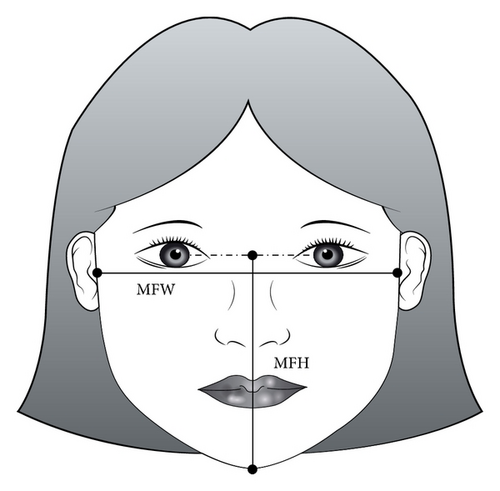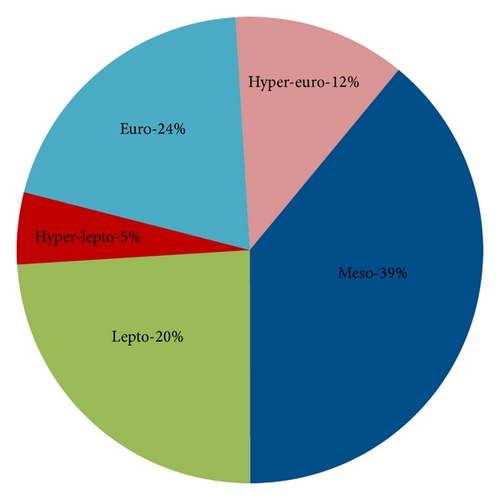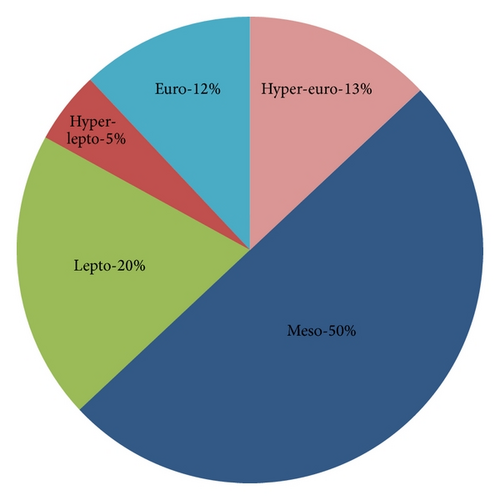A Study of Facial Index among Malay Population
Abstract
Facial analysis is anthropologically useful to identify the racial, ethnical, and sexual differences. The present study was done to see the sex difference and variation of facial index among Malaysian population. Cross-sectional descriptive type of study was done in Anatomy Department in UniKL RCMP which was performed on 81 Malay people (40 males, 41 females) aged 19–30 years. To measure the morphological parameters (facial height, facial width, and facial index), digital slide calliper and scale were used. There were significant differences found in all facial parameters of males compared with the females. The mean morphological facial height was 111.9 ± 8.4 and morphological facial width was 127.3 ± 8.0. The range of facial index was 67.44–106.90 for males and 75.21–97.99 for females. The total facial index was calculated according to the formula and the results obtained were analyzed statistically using the t-test which was statistically significant (0.003). The dominant phenotype in Malay population was mesoprosopic or round face (45%) and least common face type was hyperleptoprosopic or very long face (5%). There were significant variations in the face index between Malay males and females; further study with large sample size in different races in Malaysia is recommended.
1. Introduction
Two persons are never alike in their measurable characters [1] and hence study of intra- and interpopulation variations among different morphological characters has long been an interest of the anthropologists [2, 3]. Anthropometry constitutes the technique of expressing quantitatively the form of the body and the sexual dimorphism refers to phenotypic characteristics that differ between males and females of the same species [4, 5]. For evaluation of these variations it should be established for a particular population [6]. The comparison of the changes in facial index between parents, offspring, and sibling can give the clue to genetic transmission of inherited characters [7, 8]. Human facial contour has always been an interesting subject for anatomists, anthropologists, plastic surgeons, and artists and also the identification of an individual’s race is an essential component in forensic identification and reconstructive surgery [7]. Accurate facial analysis such as facial height, facial width, and facial index is essential for diagnosis of genetic and acquired anomalies for the study of normal and abnormal growth and for morphometric investigations. Facial index may be an important factor in increasing susceptibility to obstructive sleep apnea as europrosopic facial type favors the nasal breathing mode [8]. It clearly indicates that there is research vacuum in facial height, facial width, and facial index; that is why it demands more studies.
2. Material and Method
-
Nasion (n): the point on the root of the nose where the midsagittal plane cuts the nasofrontal sutures.
-
Gnathion (gn): the lowest point of mandible where the lower margin of the lower jaw is intersected by the midsagittal plane.
-
Zygion (zy): it is the most laterally placed point on the zygomatic arch.
-
Prosopic index (PI) = (Facial height/Facial width) × 100.
The above index was determined on the basis of international anatomical descriptions. Based on this index, the types of face shapes were categorized according to Banister’s classification as shown in Table 1.
| Face shape | Range of prosopic index |
|---|---|
| (1) Hypereuroprosopic (very broad face) | <79.9 |
| (2) Europrosopic (broad face) | 80–84.9 |
| (3) Mesoprosopic (round face) | 85–89.9 |
| (4) Leptoprosopic (long face) | 90–94. |
| (5) Hyperleptoprosopic (very long face) | >95 |
3. Result
The finding of the study is depicted in Tables 2, 3, and 4. In general, females showed the minimal measurement as compared to males in both variables. The mean of female facial height was 107.00 ± 8.4 but in males it was 117.7 ± 7.99. The mean facial width was 129.9 ± 7.7 and 125.0 ± 7.5 in males and females, respectively. Combined male and female facial height was lower than the facial width in Malay population.
Sex (n) |
Facial height (mm) Mean ± SD |
Range of facial height (mm) |
Facial width (mm) Mean ± SD |
Range of facial width |
|---|---|---|---|---|
| Male | 117.4 ± 7.998 | 98.54–130.8 | 129.9 ± 7.711 | 115.6–149.2 |
| Female | 107.00 ± 8.4 | 94.6–120.9 | 125.00 ± 7.511 | 112.7–140.66 |
| Combined | 111.9 ± 8.4 | 127.3 ± 8.0 |
Sex (n) |
Facial index range |
Facial index Mean ± SD |
P value |
|---|---|---|---|
| Male | 67.44–106.90 | 90.85 ± 8.38 | 0.003 *** |
| Female | 75.21–97.99 | 85.86 ± 5.69 |
- ***Statistically Highly Significant.
| Sex | Hypereuroprosopic <80 |
Europrosopic 80–85 |
Mesoprosopic 85–90 |
Leptoprosopic 90–95 |
Hyperleptoprosopic >95 |
Total |
|---|---|---|---|---|---|---|
| Male | 5 | 5 | 20 | 8 | 2 | 40 |
| Female | 5 | 10 | 16 | 8 | 2 | 41 |
| Total | 10 | 15 | 36 | 16 | 4 | 81 |
| % | 12% | 18% | 45% | 20% | 5% | |
In Table 3 among Malay males the range of facial index was 67.44–106.90 but for females it was 75.21–97.99. The mean ± SD of facial index of males and females was 90.85 ± 8.38 and 85.86 ± 5.69, respectively. There was a highly significant (0.003) difference in the mean value of facial index between males and females (Figures 2 and 3).
In Table 4 the result showed that the dominant type of facial shape for Malaysian males and females was mesoprosopic (round face), which was 50% and 39% for males and females, respectively. The second commonest type of facial shape for females was europrosopic (broad face) which was 24% but for males it was leptoprosopic (long face) which was 20%. The least common facial shape was hyperleptoprosopic (very long face) and it was 5% for both sexes.
4. Discussion
This present study showed that the range of morphological facial height for Malay females was 94.6–120.9 mm and in Malay males was 98.54–130.8 mm. The range of morphological facial width was 115.6–149.2 mm and 112.7–140.66 mm for females and males, respectively. In general all female values are lesser than those of males. Shetti et al. [2] had made a similar study on Malaysian students of Melaka Manipal Medical College and showed that all female values were lesser than those of males, and the mean values were also similar to the present study which were 111.9 ± 8.4 (MFH) and 127.3 ± 8.0 (MFW) (Figure 1). Ngeow and Aljunid carried out a similar study on young adult Malaysian Malays and found that width of the face was greater (male 121.0–153.0, female 123.0–142.0 mm) than the height of the face (male 106.3–134.7, female 93.9–128.9 mm) which was similar to the present study [3]. Eliakim-Ikechukwu et al. (2012), Omotoso et al. (2011), and Osunwoke et al. (2011) had carried out studies on Nigerian population on sexual dimorphism and significant difference was found between male and female facial indexes; this may be due to the male hormone testosterone which causes the changes in the shape of the face between the two sexes [4, 5, 9]. There was another study in China, done by Kurnia et al. (2012) who found that the mean facial index was 89.02 ± 4.92 for males and 88.52 ± 4.89 for females and the dominant type of face was mesoprosopic (40% males and 30.30% females) [8]. Another study by Salve et al. (2012) in Indian population showed that the similar result for male and as the present study as shown in Table 2. In the Indian study, the dominant face type for males was mesoprosopic but for females it was europrosopic type, but in our study the dominant type of face for the Malays was mesoprosopic and europrosopic type of face was the second common one for Malay females. This similarity may be due to similarity of environmental condition [6]. On the other hand, Praveen Kumar Doni et al. (2013) had made a study in South Indian population and found that the dominant face type was hyperleptoprosopic, which was the least common type in Malays (5%) [7]. Jeremić et al. (2013) carried out a study in Central Serbia and showed a similar result of sexual dimorphism which was significant as in the present study, but the dominant face type was leptoprosopic followed by mesoprosopic which was not similar to our study [10].



5. Conclusion
The mean facial index of Malay population has been identified. There is a significant difference present in facial index between the males and females (P = 0.003). The predominant face type for Malay population is mesoprosopic (50% for males and 39% for females). The second common type of face for males is leptoprosopic (20%) but for females it is europrosopic (24%) and the least common face type for Malays is hyperleptoprosopic (5%).
Conflict of Interests
The authors declare that there is no conflict of interests regarding the publication of this paper.




